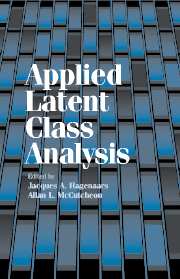Book contents
- Frontmatter
- Contents
- Contributors
- Preface
- INTRODUCTION
- CLASSIFICATION AND MEASUREMENT
- CAUSAL ANALYSIS AND DYNAMIC MODELS
- 8 Use of Categorical and Continuous Covariates in Latent Class Analysis
- 9 Directed Loglinear Modeling with Latent Variables: Causal Models for Categorical Data with Nonsystematic and Systematic Measurement Errors
- 10 Latent Class Models for Longitudinal Data
- 11 Latent Markov Chains
- UNOBSERVED HETEROGENEITY AND NONRESPONSE
- Appendix A: Notational Conventions
- Appendix B: Further Readings
- Appendix C: Selected Software; Webpage
- Index
8 - Use of Categorical and Continuous Covariates in Latent Class Analysis
Published online by Cambridge University Press: 31 July 2009
- Frontmatter
- Contents
- Contributors
- Preface
- INTRODUCTION
- CLASSIFICATION AND MEASUREMENT
- CAUSAL ANALYSIS AND DYNAMIC MODELS
- 8 Use of Categorical and Continuous Covariates in Latent Class Analysis
- 9 Directed Loglinear Modeling with Latent Variables: Causal Models for Categorical Data with Nonsystematic and Systematic Measurement Errors
- 10 Latent Class Models for Longitudinal Data
- 11 Latent Markov Chains
- UNOBSERVED HETEROGENEITY AND NONRESPONSE
- Appendix A: Notational Conventions
- Appendix B: Further Readings
- Appendix C: Selected Software; Webpage
- Index
Summary
INTRODUCTION
In this chapter, we consider latent class models that include concomitant variables. As in an analysis of variance, concomitant variables may be classified as blocking variables or as continuous covariates. For example, cases may be grouped by sex in order to investigate the equivalence of latent class proportions and/or conditional probabilities for male and female respondents. Sex would play the role of a blocking, or stratification, variable, and standard methods of estimation and hypothesis testing for latent class models can be easily extended to situations of this type (Clogg and Goodman, 1984, 1985, 1986). In contrast, latent class parameters can be conditioned on continuous concomitant variables in a manner analogous to the analysis of covariance. For example, in a two-class model, the proportion of cases in the first latent class, say, might be represented as a function of a respondent characteristic such as scholastic aptitude (e.g., SAT score). Modeling a concomitant variable of this type is more complicated than modeling a blocking variable because a specific functional form must be assumed for the relationship between the covariate and latent class proportion (Dayton and Macready, 1988a, 1988b). In an analysis of covariance, the functional form is ordinarily assumed to be linear, but this is clearly unsatisfactory for representing relations when the variable being modeled is a probability.
In the ensuing sections of this chapter, we present and illustrate theory related to categorical blocking variables and continuous covariates.
- Type
- Chapter
- Information
- Applied Latent Class Analysis , pp. 213 - 233Publisher: Cambridge University PressPrint publication year: 2002
- 11
- Cited by



